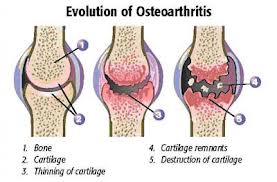
Often the breakdown of a joint's cartilage can lead to osteoarthritis, which is the most common form of arthritis. The breakdown of the cartilage leads to bone on bone and deterioration of the bones. The protective cartilage is suppose to
prevent the damage and act as a shock absorber between the bones. As the cartilage deteriorates that may lead to additional stretching of other tendons and ligaments in the supporting structures. The additonal stress now placed on the
ligaments and tendons can also contribute to the pain the patient feels. If left untreated there eventually will be chronic pain and gradual loss of motion inhibiting the patient's ability to do things and care for him or herself. Osteoarthritis generally
occurs in mid age and older people, more prevalent in women than men, and rare in younger people. Osteoarthritis basically affects most mobile joint areas, as distinguished from non mobile such as cranial bones.
A progressor of osteoarthritis is being overweight. The actual causation though is not the weight, but the lack of supporting musculature to support the additional weight. If the muscles do not support the weight then the joints bear the burden
of supporting it and the cartilage is exposed to more impact and compaction. Tendons and ligaments stretch due to the prolonged weight. Over time, this is why middle age/older disease the cumulative effects occur and, the diagnosis becomes
osteoarthritis.
There is one simple way to prevent the occurence, or correct the anatomical problems associated with osteoarthritis. The longer, more time involved process is simple exercising such as what is listed below from Todd P. Stitik, MD, professor
of physical medicine and rehabilitation at UMDNJ-New Jersey Medical School. This type exercise specific to knee osteoarthritis illustrates the exercise logic and methodology.
The single best curative and prevention is to do as recommened in traditional exercise however supplement the exercises with about 7 - 10 reps using functional electrical stimulation. This is simply using a device such as the Infrex
Plus or the soon to be released Infrex FRM to strengthen the muscles quicker and with less pain. The same concepts that allow an ACL reconstruction surgery patient to return to full function in 3 months, not 9 months applies.
Where the condition, such as osteoarthritis, has occurred over time, the period of regaining strength; increasing overall muscle strength, will stop the progression of the disease and can reverse the symptomatic issue of pain. The addition of high frequency Infrex electrical stimulation will quickly reverse causation and restore full range of motion, without pain.
Video below explains the functional restoration process:


